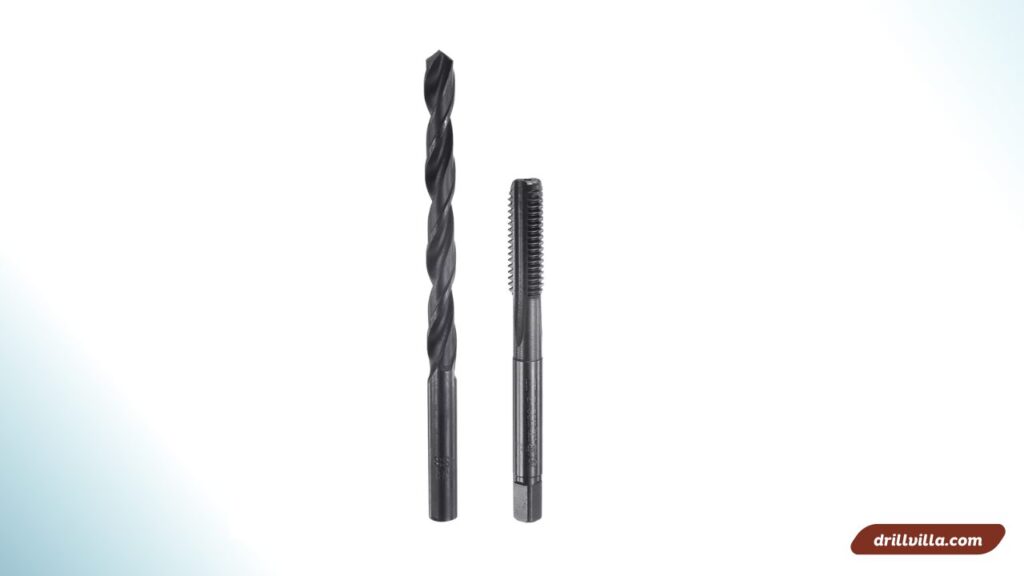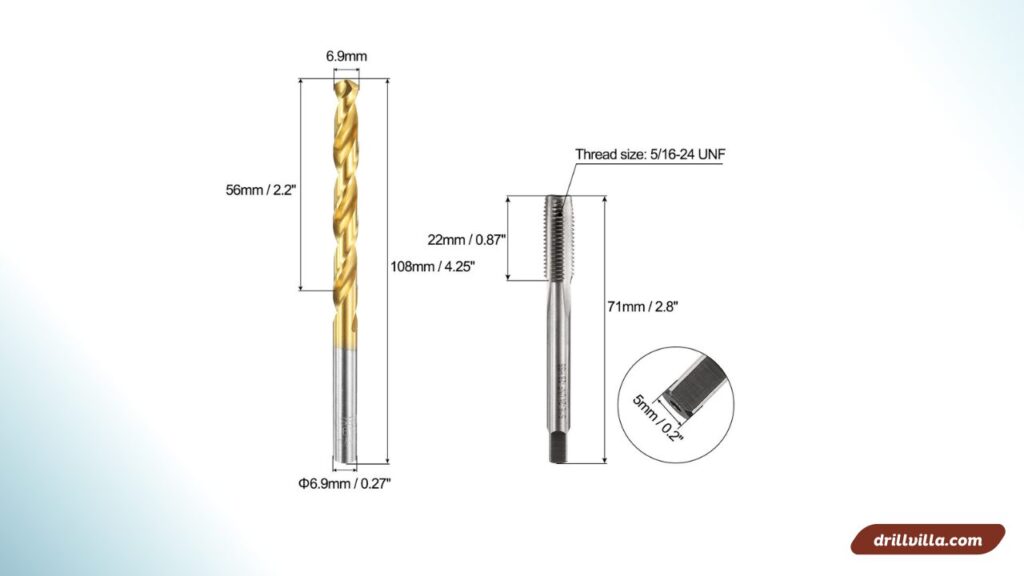I still remember the first time I had to tap a hole for a 5/16 bolt. I stood in my garage staring at a bunch of drill bits, totally clueless about which one to use. I didn’t want to ruin the part or strip the threads. Sound familiar?
In this article, I’m going to break down exactly what size of drill bit for a 5/16 tap you need, and I’ll do it in a way that feels like we’re having a chat over coffee. So grab a cup, and let’s dive in.
Article Summary
- Understanding Taps and Threads (Let’s Keep It Simple)
- Thread Pitches for 5/16 Taps
- Metric vs Imperial: Don’t Mix ‘Em Up
- Why the Right Drill Bit Size Matters
- How to Find the Right Drill Bit Size Every Time
- My Go-To Tools for Tapping Success
- Real-World Example: Installing Threaded Inserts in Wood
- Tapping Tips From the Garage
- Frequently Asked Questions
- What Size Drill Bit Is Needed for a 5/16 Tap?
- What Size Drill Bit for 5/16 Self-Tapping Bolt?
- Wrapping It All Up
Understanding Taps and Threads (Let’s Keep It Simple)
Before we even talk about drill bit sizes, let’s clear the air on what tapping really is.
What Does Tapping Mean?
Tapping is the process of cutting internal threads in a hole. Think of it like carving a spiral path so a bolt can fit snugly inside.
What Is a 5/16 Tap?
A 5/16 tap means you’re cutting threads to fit a 5/16 inch bolt. But here’s the tricky part: 5/16 taps come in different thread pitches.
Thread Pitches for 5/16 Taps
There are two common thread pitches for a 5/16 tap:
- 5/16-18 UNC (Coarse Thread)
- 5/16-24 UNF (Fine Thread)
Let me tell you, I learned the hard way that coarse and fine threads need different drill bits. I used a bit that was too small once and snapped the tap. Not fun.
| Tap Size | Thread Pitch | Drill Bit Size | Drill Size (inches) | Thread Type |
|---|---|---|---|---|
| 5/16-18 | Coarse | F | 0.257″ | UNC |
| 5/16-24 | Fine | I | 0.272″ | UNF |
Pro Tip: Lettered drill bits can be confusing. Think of them as special sizes between the standard fractions.

Metric vs Imperial: Don’t Mix ‘Em Up
Just a heads-up—make sure you’re working in the same measurement system. One time I used a metric bit because it “looked close enough.” Big mistake.
If you’re using a 5/16 tap (which is imperial), you need to use imperial drill bits unless you have a metric equivalent that matches exactly.
Why the Right Drill Bit Size Matters
Let me put it this way:
- Use a drill bit that’s too small = risk snapping the tap.
- Use one that’s too big = weak threads.
You want that Goldilocks size—just right.
How to Find the Right Drill Bit Size Every Time
Here’s how I do it:
- Check the tap size and thread pitch.
- Use a drill size chart. (You can print one and keep it near your toolbox)
- Double-check with a caliper if needed.
Drill Size Chart for Common Taps
| Tap Size | Thread Count | Drill Size | Decimal (inches) |
|---|---|---|---|
| 5/16-18 | 18 TPI | F | 0.257″ |
| 5/16-24 | 24 TPI | I | 0.272″ |
If you don’t have lettered bits, here’s what you can use instead:
- For 5/16-18: Use a 1/4″ bit if you’re careful, but F is best.
- For 5/16-24: You can try 17/64″, but again, I is ideal.
My Go-To Tools for Tapping Success
Must-Haves:
- Tap wrench (not pliers—trust me)
- Cutting fluid (makes tapping smoother)
- Center punch (keeps the bit from wandering)
Optional but Awesome:
- Drill press
- Tap guide block
Real-World Example: Installing Threaded Inserts in Wood
One weekend, I was installing threaded inserts in a wooden tabletop. I needed 5/16-18 inserts, and the package said to use a 3/8″ drill bit. Confusing, right?
But here’s the deal:
- For metal, use the drill bit size for tapping.
- For wood with inserts, the bit might be bigger to accommodate the outer sleeve.
So always read the instructions. Different material, different game.
Tapping Tips From the Garage
Here are a few lessons I’ve learned (sometimes the hard way):
- Always use cutting fluid to avoid friction and broken taps.
- Turn the tap slowly and back it out often to clear chips.
- Secure your workpiece so it doesn’t shift mid-tap.
- Practice on scrap metal before touching your project.
Frequently Asked Questions
Can I use a regular twist drill for tapping holes?
Yes, just make sure it’s the correct size. A twist drill works fine if it’s sharp and stable.
What if I don’t have an F or I bit?
You can use the closest fractional size, but test it on scrap first.
Do I need a drill press to tap a hole?
Nope. A drill press helps, but hand drills work too if you go slow and steady.
Is tapping aluminum different than steel?
Yes. Aluminum is softer, so it’s easier. But it can clog the tap, so use cutting fluid generously.
Sure! Here’s the SEO-optimized, high-readability content for the two subheadings. The tone is conversational, and I’ve used real-life examples and simplified the language for clarity and flow.
What Size Drill Bit Is Needed for a 5/16 Tap?
Let me tell you, I’ve messed up more threads than I’d like to admit just because I didn’t pick the right drill bit. If you’re working on a project and need to tap a 5/16 hole, I totally get why you’re asking this. It might seem like a small detail, but it makes a big difference.
So, what size of drill bit for a 5/16 tap? The answer depends on the thread pitch. Don’t worry—this sounds more complicated than it really is.
Here’s the Simple Breakdown:
Let’s say you’re working with a 5/16-18 tap. That “18” means there are 18 threads per inch. In that case, you’ll want to use a letter F drill bit. That’s 0.257 inches in diameter.
But if you’re using a 5/16-24 tap (which is the finer thread version), you’ll need a slightly smaller bit—a #1 drill bit, which is about 0.228 inches.
Real-Life Tip:
When I was fixing a stripped thread in my lawn mower deck, I grabbed a standard 5/16-18 tap and didn’t bother checking the bit size. I drilled it out with a 1/4″ bit, thinking it’d be “close enough.” Well, guess what? The tap wouldn’t bite right, and I had to redo the hole. That’s when I learned: use the right bit, or you risk ruining your tap or the hole.
Quick Reference Table:
| Tap Size | Thread Pitch | Drill Bit Size | Drill Bit Type |
|---|---|---|---|
| 5/16-18 UNC | Coarse | 0.257 in | Letter F |
| 5/16-24 UNF | Fine | 0.228 in | #1 Drill Bit |
Pro Tips:
- Always double-check the tap size on the packaging or tool.
- Use cutting oil to reduce friction and heat.
- Drill straight. A wobbly hole = bad threads.
What Size Drill Bit for 5/16 Self-Tapping Bolt?
Ah, the good old self-tapping bolt. I’ve used these plenty of times—when I wanted to skip tapping threads myself or when I was working with sheet metal. They’re great, but getting the drill bit size right is crucial. Otherwise, the bolt either won’t grab, or it’ll split your material.
So if you’re wondering what size of drill bit for a 5/16 tap, specifically for a self-tapping bolt, here’s what I’ve learned through trial and (painful) error.
Here’s the Rule of Thumb:
Self-tapping bolts need a pilot hole—not too big, not too small. For a 5/16-inch self-tapping bolt, the pilot hole usually ranges from 0.250 to 0.265 inches.
But this varies based on two things:
- The type of material (metal, plastic, wood)
- The thread type on the bolt
A Quick Example From My Garage:
Last fall, I was mounting brackets onto the steel frame of my truck bed. I used 5/16 self-tapping bolts. I thought, “Hey, I’ll just go with a 1/4″ drill bit.” Big mistake! The bolt wouldn’t go in all the way, and I snapped one trying to force it. I re-drilled with a 17/64″ bit and—boom—it went in smooth like butter.

Pilot Hole Size Chart for 5/16 Self-Tapping Bolts:
| Material | Suggested Drill Bit | Decimal Size |
|---|---|---|
| Soft Wood | 1/4″ | 0.250 in |
| Hard Wood | 17/64″ | 0.266 in |
| Sheet Metal | 9/32″ | 0.281 in |
| Mild Steel | 17/64″ | 0.266 in |
🛠️ Tips You’ll Thank Me For:
- If you’re unsure, test on scrap material first.
- Use a slightly larger bit for harder materials.
- If the bolt spins or strips, you’ve drilled too wide.
- Don’t forget to wear safety glasses—self-tappers can snap if you’re not careful.
Wrapping It All Up
So, what size of drill bit for a 5/16 tap? It all depends on the thread pitch:
- Use a size F drill bit (0.257″) for 5/16-18 UNC
- Use a size I drill bit (0.272″) for 5/16-24 UNF
If you don’t have lettered bits, go for 1/4″ or 17/64″ as close alternates.
I hope this guide makes tapping a whole lot less intimidating. The first time I tapped a hole right, it felt awesome—like I unlocked a whole new level of DIY. And I know you will too.
Keep wrenching, stay safe, and may your threads be smooth!
Know More:
- How Much Does It Cost To Drill A Bowling Ball?
- What Size Drill Bit for 10 Screw
- Are You Supposed To Submerge Powered Orthopedic Drills For Decontamination?
- A 135 Split Point Cobalt Letter Drill Bits?
- How Long Does It Take to Drill a Water Well?
- What Type of Drill Bits Won’t Snap?
- What Are the Best Drill Bits for Stainless Steel?